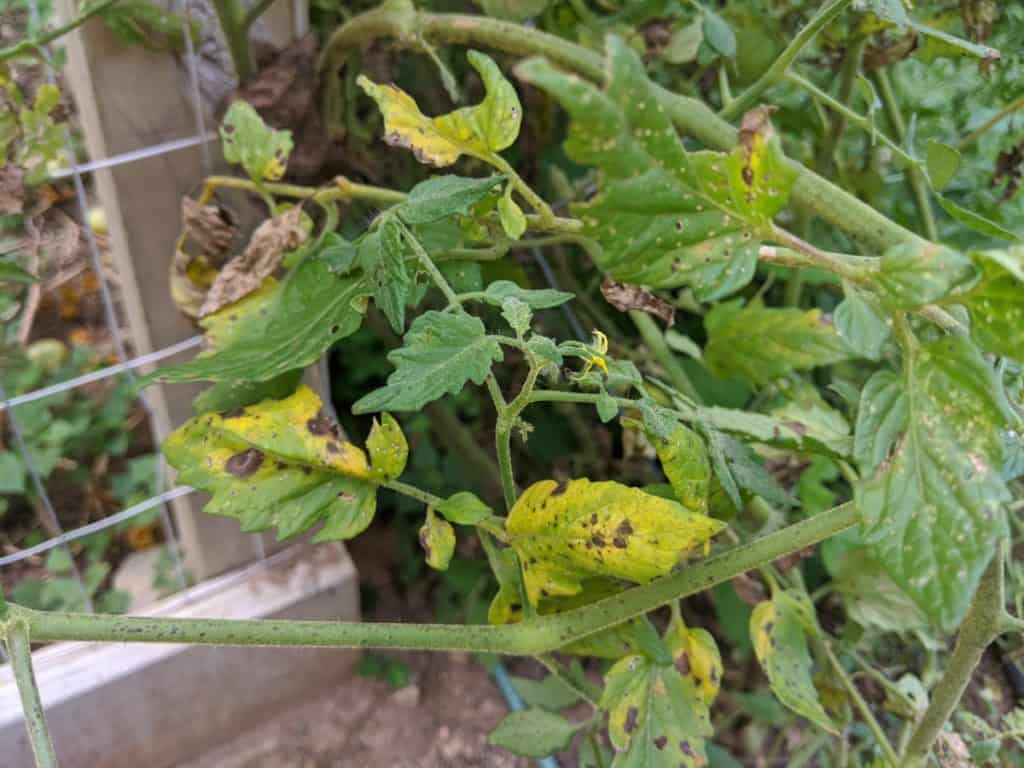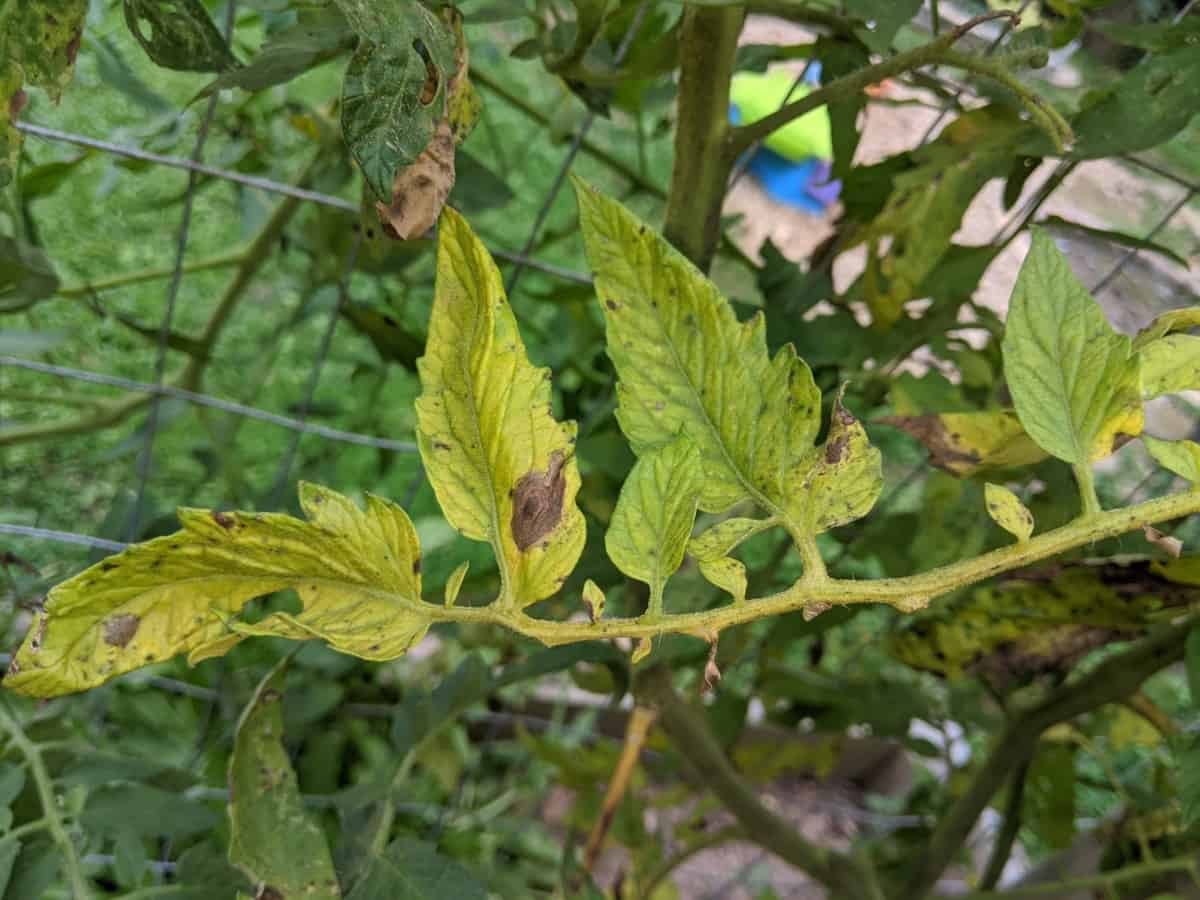
Planting time in your vegetable garden is a great time of year, but after pulling weeds and watching your tomato plants grow, it can be disappointing when some of the leaves on your tomato plants start to turn yellow.
Through my own experience and research, I will explain some of the reasons this occurs and what you can do to avoid or remedy the problem.
Tomato leaves turn yellow for various reasons including a lack of pruning, nutrient deficiencies in soil, overwatering or underwatering of the plant, pests, lack of sunlight on leaves at the plant base, and several diseases such as early blight.
Reasons Tomato Leaves Turn Yellow
Lack of Pruning
If you only see yellow tomato leaves at the bottom of your tomato plant there may be no need to worry. Tomato plants naturally abandon lower leaves during the growing season causing them to turn yellow and brown, while focusing energy on upper leaves that receive more sunlight.
However, leaves and stems that touch the ground at the base of the plant are more susceptible to disease. By pruning the bottom leaves of the tomato plant you promote good airflow, reduce the risk of plant diseases, and lessen the yellowing of tomato leaves.
Nutrient Deficiencies in Soil
One reason you find yellow leaves on your tomato plant is that you have a deficient soil lacking nitrogen. Tomato plants need nitrogen to promote healthy plant stem and foliage growth.
Without a proper amount of nitrogen, a tomato plant will have yellowing leaves causing stunted growth and spindly stems. You do need to be careful when adding extra nitrogen as too much can cause plant burn.
Additional nutrient deficiencies in the soil are often caused when tomatoes are planted in the same garden bed year after year, causing the soil to become exhausted and increasing the likely hood of yellow leaves.
Some of these nutrients include calcium, sulfur, magnesium, and potassium, and depending on your soil type you may be lacking one more than another.
It’s important to rotate your crops by planting different vegetables in areas of your garden each year. Another great way to combat these deficiencies is to amend your soil with compost each year, this will help create a healthy microbial system in your soil composition.
Tomato growers know it’s a good idea to do a soil test every few years, making sure the soil Ph is in the 6.0 to 6.8 range.
Overwatering the Tomato Plant
When a tomato plant receives too much water the roots begin to drown and cause root rot making the tomato leaves wilt and turn yellow or brown.
A tomato plant growing in the ground generally needs about 1-2 inches of water per week to thrive. This is why you often see yellow plant leaves after it has been raining for several days in a row as the tomato has received excessive amounts of water.
Underwatering the Tomato Plant
During the particularly hot days of summer, you should water your tomato plants once a day. When watering a tomato plant, do so at the base of the plant during the morning before it gets hot.
If you have just purchased small tomato plants from a garden center you need to make sure to give them a good soak as soon as you put them in the ground.
Tomato Plant Pests and Insects
There are a variety of pests that can contribute to the yellowing of tomato leaves, these include whiteflies, aphids, psyllids, flea beetles, spider mites, thrips, cutworms, and hornworms.
While you can pick off tomato hornworms and cutworms by hand, insects require a more involved approach when trying to save the entire tomato plant.
- Aphids: Create a homemade insecticidal soap. First, get a spray bottle and fill it with one quart of water (32 ounces) a few teaspoons of dish soap and spray the entire plant including flowers and older leaves. This will dry out the aphids causing them to die while saving your tomato plant leaves.
- Whiteflies: Spray the underside of the tomato leaves and the insect pests directly with insecticidal soap. You can also spray them with Organic Neem Oil.
- Psyllids: Spraying the plant thoroughly with organic neem oil will kill Psyllids and prevent them from laying eggs. The natural predators of this pest are lacewings and ladybugs.
- Flea beetles: The Farmers Almanac recommends a homemade spray of 5 cups water, 1 tablespoon dish soap, and 2 cups of rubbing alcohol. Test out the spray by putting it on a few leaves of mature plants. If you don’t notice any adverse effects on the entire leaf, spray the rest of the tomato plants. Another repellent, plain talcum powder works by dusting the plant, according to the Farmers Almanac.
- Spider mites: Using a homemade insecticidal soap mentioned previously is a way to get rid of these mites another solution is to mix one part water and one part rubbing alcohol. Alcohol won’t harm the plants but will kill the mites.
- Thrips: Keeping weeds away from the outer edges of your tomato leaves will reduce Thrips, and a well-pruned tomato plant will help as well. If you already have an infestation using an insecticidal soap will get rid of the pest or you can purchase a commercial product to handle the job. Ladybugs also eat Thrips so planting dill, coriander, or Queen Ann’s lace will attract ladybugs to your vegetable garden.

Tomato Plant Diseases
There are fungal diseases and wilt diseases that can cause the leaves of tomatoes to turn yellow. Several of these are Fusarium and Verticillium wilt, early blight late blight, tomato leaf curl virus, and anthracnose.
Fusarium Wilt: This fungal disease causes yellowing of the lower leaves, brown spots, and premature leaf drop. It thrives in soil with bad drainage and high moisture.
Pruning dead leaves and removing fallen plant matter will help control the issue. Using fungicides to remove it from the soil as well as planting clean seeds of tomato resistant varieties is often the best defense against the disease.
Verticillium wilt: This pathogen causes wilting and yellowing of tomato leaves. Rotating your vegetables each year and making raised beds are helpful tips to avoid the issue.
Early blight: A very common tomato disease caused by the fungus Alternaria solani.
Brown spots first appear and yellowing of leaves occurs in older and less hardy tomato plants. You can spray fungicide on infected plants but you may just want to remove the infected plant completely.
Tips to mitigate the issue include rotating your vegetables to different areas of your garden and destroying infected plants while making sure not to put them in your compost pile.
Late blight: The pathogen Phytophthora infestans causes late blight in tomato plants. It can infect the fruit, stems, and leaves of the tomato plant. Ways to prevent the issue include vegetable rotation, weekly pruning, and watering the base of the plant instead of leaves.
If you have a plant with late blight it should be destroyed and burned as late as it can spread in your garden very quickly.
Tomato leaf curl virus: This virus is transmitted by whiteflies and is one of the most devastating diseases a tomato plant can get. Leaves will start to curl upwards or droop downwards with the leaves turning a faded yellow.
You can use homemade insecticidal soap to help control the issue.
Conclusion
When working in your vegetable garden, keep an eye on issues that may crop up. Early prevention is the key to maintaining a healthy garden and ensuring a wonderful harvest.
Hopefully, some of these tips will help the next time you start to see a few yellow leaves on your tomatoes. Happy Harvesting.

